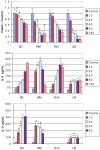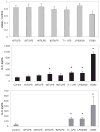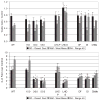Inflammatory cytokines and cell death in BEAS-2B lung cells treated with soil dust, lipopolysaccharide, and surface-modified particles
- PMID: 15310859
- PMCID: PMC2292468
- DOI: 10.1093/toxsci/kfh248
Inflammatory cytokines and cell death in BEAS-2B lung cells treated with soil dust, lipopolysaccharide, and surface-modified particles
Abstract
Cultured human lung epithelial cells (BEAS-2B) were treated in vitro with PM(2.5)-enriched particles of soil-derived mineral dust from nine sites in the western United States. The particle samples simulate windblown dust and vehicle-generated emissions from unpaved roads. Five of the sites yielded relatively benign dust. Particles from three sites caused IL-6 release when cells were treated for 24 h at doses from 20 to 80 microg/cm(2), and particles from one site were highly cytotoxic. The particle components or characteristics that caused the IL-6 release were stable at temperatures below 150 degrees C, but were inactivated by treatment at 300-550 degrees C. The active factors were also associated predominantly with the insoluble fraction, and were partially attenuated by leaching with aqueous and organic solvents. The IL-6 release caused by the particles was much greater than the cytokine response to either lipopolysaccharide (LPS) or to surrogate particles of titanium dioxide mixed with LPS, suggesting that endotoxin was not a major factor in the inflammatory response. The release of IL-8 in response to particle treatment was qualitatively similar to the IL-6 response, but release of TNF-alpha was not detected at the 24-h time point. The combined results support the hypothesis that some ambient dusts from geological sources can cause cell death and cytokine release in a lung cell line that is widely used as an in vitro model to study mechanisms of environmental respiratory injury.
Figures





Similar articles
-
Diesel exhaust particles induced release of interleukin 6 and 8 by (primed) human bronchial epithelial cells (BEAS 2B) in vitro.Exp Lung Res. 1998 Jan-Feb;24(1):85-100. doi: 10.3109/01902149809046056. Exp Lung Res. 1998. PMID: 9457471
-
Correlation of in vitro cytokine responses with the chemical composition of soil-derived particulate matter.Environ Health Perspect. 2006 Mar;114(3):341-9. doi: 10.1289/ehp.8360. Environ Health Perspect. 2006. PMID: 16507455 Free PMC article.
-
Budesonide enhances Toll-like receptor 2 expression in activated bronchial epithelial cells.Inhal Toxicol. 2010 May;22(6):493-9. doi: 10.3109/08958370903521216. Inhal Toxicol. 2010. PMID: 20388003
-
Airway epithelial epidermal growth factor receptor mediates hogbarn dust-induced cytokine release but not Ca2+ response.Am J Respir Cell Mol Biol. 2011 Oct;45(4):882-8. doi: 10.1165/rcmb.2010-0419OC. Epub 2011 Mar 25. Am J Respir Cell Mol Biol. 2011. PMID: 21441380 Free PMC article.
-
cAMP-dependent protein kinase activation decreases cytokine release in bronchial epithelial cells.Am J Physiol Lung Cell Mol Physiol. 2014 Oct 15;307(8):L643-51. doi: 10.1152/ajplung.00373.2013. Epub 2014 Aug 22. Am J Physiol Lung Cell Mol Physiol. 2014. PMID: 25150062 Free PMC article.
Cited by
-
Temporal-spatial analysis of U.S.-Mexico border environmental fine and coarse PM air sample extract activity in human bronchial epithelial cells.Toxicol Appl Pharmacol. 2009 Jul 1;238(1):1-10. doi: 10.1016/j.taap.2009.04.021. Epub 2009 May 3. Toxicol Appl Pharmacol. 2009. PMID: 19410595 Free PMC article.
-
California wildfires of 2008: coarse and fine particulate matter toxicity.Environ Health Perspect. 2009 Jun;117(6):893-7. doi: 10.1289/ehp.0800166. Epub 2009 Feb 2. Environ Health Perspect. 2009. PMID: 19590679 Free PMC article.
-
The regulatory role of ACP5 in the diesel exhaust particle-induced AHR inflammatory signaling pathway in a human bronchial epithelial cell line.Sci Rep. 2025 Mar 14;15(1):8826. doi: 10.1038/s41598-024-84280-9. Sci Rep. 2025. PMID: 40087344 Free PMC article.
-
Lung response to coarse PM: bioassay in mice.Toxicol Appl Pharmacol. 2008 Jul 15;230(2):159-66. doi: 10.1016/j.taap.2008.02.013. Epub 2008 Feb 26. Toxicol Appl Pharmacol. 2008. PMID: 18384828 Free PMC article.
-
African Dust Storms Reaching Puerto Rican Coast Stimulate the Secretion of IL-6 and IL-8 and Cause Cytotoxicity to Human Bronchial Epithelial Cells (BEAS-2B).Health (Irvine Calif). 2013 Oct;5(10B):14-28. doi: 10.4236/health.2013.510A2003. Health (Irvine Calif). 2013. PMID: 25002916 Free PMC article.
References
-
- Adamson IY, Prieditis H, Vincent R. Pulmonary toxicity of an atmospheric particulate sample is due to the soluble fraction. Toxicol Appl Pharmacol. 1999;157:43–50. - PubMed
-
- Agopyan N, Li L, Yu S, Simon SA. Negatively charged 2 and 10-μm particles activate vanilloid receptors, increase cAMP and induce cytokine release. Toxicol Appl Pharmacol. 2003;186:63–76. - PubMed
-
- Becher R, Hetland RB, Refsnes M, Dahl JE, Dahlman HJ, Schwarze PE. Rat lung inflammatory responses after in vivo and in vitro exposure to various stone particles. Inhal Toxicol. 2001;13:789–805. - PubMed
-
- Carter JD, Ghio AJ, Samet JM, Devlin RB. Cytokine production by human airway epithelial cells after exposure to an air pollution particle is metal-dependent. Toxicol Appl Pharmacol. 1997;146:180–188. - PubMed

